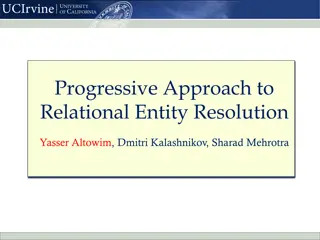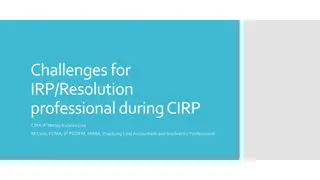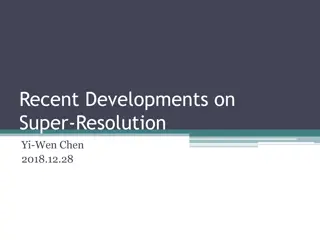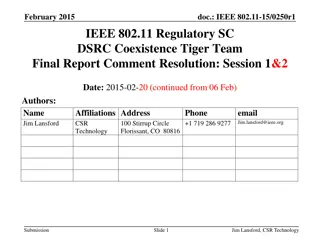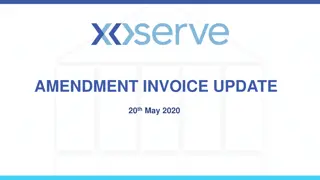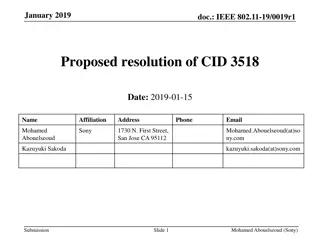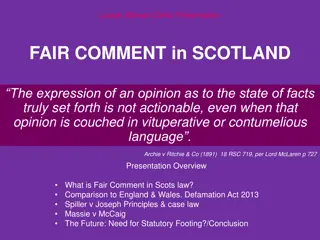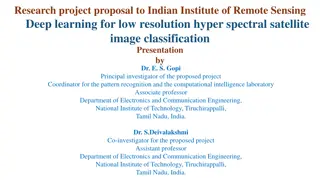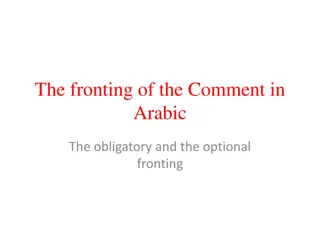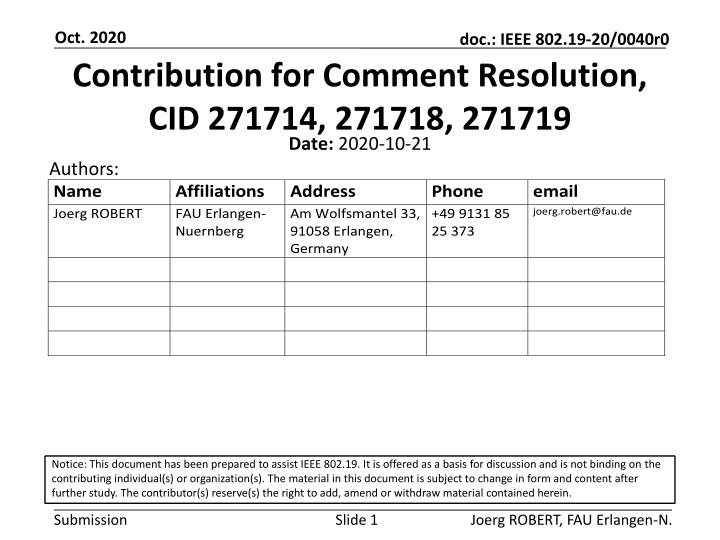
IEEE 802.19 Oct 2020 Comment Resolution Contributions
Explore the Oct 2020 comment resolution contributions regarding CID 271714, 271718, and 271719 by Joerg Robert from FAU Erlangen. The document proposes resolutions for specific comments and actions related to duty cycle restrictions, frequency bands, and table updates within the IEEE 802.19 framework.
Download Presentation

Please find below an Image/Link to download the presentation.
The content on the website is provided AS IS for your information and personal use only. It may not be sold, licensed, or shared on other websites without obtaining consent from the author. If you encounter any issues during the download, it is possible that the publisher has removed the file from their server.
You are allowed to download the files provided on this website for personal or commercial use, subject to the condition that they are used lawfully. All files are the property of their respective owners.
The content on the website is provided AS IS for your information and personal use only. It may not be sold, licensed, or shared on other websites without obtaining consent from the author.
E N D
Presentation Transcript
Oct. 2020 Contribution for Comment Resolution, CID 271714, 271718, 271719 Date: 2020-10-21 Authors: doc.: IEEE 802.19-20/0040r0 Name Joerg ROBERT Affiliations FAU Erlangen- Nuernberg Address Am Wolfsmantel 33, 91058 Erlangen, Germany Phone +49 9131 85 25 373 email joerg.robert@fau.de Notice: This document has been prepared to assist IEEE 802.19. It is offered as a basis for discussion and is not binding on the contributing individual(s) or organization(s). The material in this document is subject to change in form and content after further study. The contributor(s) reserve(s) the right to add, amend or withdraw material contained herein. Submission Slide 1 Joerg ROBERT, FAU Erlangen-N.
Oct. 2020 doc.: IEEE 802.19-20/0040r0 Abstract This document proposes comment resolutions to CID 271714, CID 271718, and CID 271719 as presented in DCN 19- 20/0036r2 Submission Slide 2 Joerg ROBERT, FAU Erlangen-N.
Oct. 2020 doc.: IEEE 802.19-20/0040r0 CID 271714 Comment: For the most part all of the technologies operating in Europe and Japan in the same band are subject to the same or similar duty cycle restrictions so I'm not sure why LoRa has a specific mention of additional duty cycle restrictions. (page 8, sec 4.5, line 14) Reviewer s proposed change: I suggest replacing the paragraph with a statement of which channel access method LoRa uses and that it is a duty cycle based technology. Submission Slide 3 Joerg ROBERT, FAU Erlangen-N.
Oct. 2020 doc.: IEEE 802.19-20/0040r0 CID 271714 Proposed Action Revise Comment Reason: Useful to mention potential restrictions in the US. Submission Slide 4 Joerg ROBERT, FAU Erlangen-N.
Oct. 2020 doc.: IEEE 802.19-20/0040r0 CID 271714 Proposed Change Replace paragraph on page 8, sec 4.5, line 14: LoRa is typically operated in the license exempt frequency bands around 900 MHz. The maximum transmit power is also region dependent and can reach up to 1000mW in the US and 500 mW in Europe. The typical transmit power is 25 mW. Furthermore, other restriction may also apply, e.g. a 0.1% or 1% maximum duty cycle for most bands in Europe, and 10% maximum duty cycle in Japan. In the US the maximum data length and the useable transmission parameters are limited by the maximum channel occupancy of 0.4s in a 20s period. Submission Slide 5 Joerg ROBERT, FAU Erlangen-N.
Oct. 2020 doc.: IEEE 802.19-20/0040r0 CID 271718 Comment: Table 3 is out of date. Wide band SRDs are now allowed to operate in 863-868MHz and 917.4-919.4MHz with a duty cycle of 2.8% for STAs and 10% for access points. Reviewer s proposed change: Update Table 3 Submission Slide 6 Joerg ROBERT, FAU Erlangen-N.
Oct. 2020 doc.: IEEE 802.19-20/0040r0 CID 271718 Proposed Action Revise Comment Reason: Table-3 shows the latest version of ETSI EN 300 220-2. However, a new version of this document is currently created containing the mentioned changes. The changes are disclosed in CEPT ERC70-03 in its last version from 12 June 2020, which will be incorporated into ETSI EN 300 220-2. The mentioned 833-868MHz band is already adopted in some EU countries (e.g. Germany). However, the mentioned 917MHz band in the is not yet adopted in most EU countries. Submission Slide 7 Joerg ROBERT, FAU Erlangen-N.
Oct. 2020 doc.: IEEE 802.19-20/0040r0 CID 271718 Proposed Change Add the following text on page 15, line 5 after and 920 MHz. : Additional spectrum allocations e.g. for IEEE Std 802.11ah are already defined in CEPT ERC Recommendation 70-03 [Bxy], and will be included in the upcoming version of ETSI EN 300-220-2. Many EU states have already adopted the use of IEEE Std 802.11ah in the frequency range 863-868 MHz. The frequency regulation defines a bandwidth between 600 kHz and 1 MHz, a maximum transmit power of 25 mW, and a duty cycle of 2.8% for end devices and 10 % for AP. In bibliography add (also correct the first entry, which is an introducing text): [Bxy] CEPT Electronic Communications Committee, ERC Recommendation 70-03: Relating to the use of Short Range Devices (SRD) , June 2020 Correct typos in Table-3, Max. TX Power (e.r.p.) , Usage Restriction , add missing % in second row last column < 10% duty cycle Change Table-3 caption: EU Wide Harmonized sub-1GHz Spectrum Allocation according to ETSI EN 300 220-2 Submission Slide 8 Joerg ROBERT, FAU Erlangen-N.
Oct. 2020 doc.: IEEE 802.19-20/0040r0 CID 271719 Comment: Since Table 3 is out of date Table 4 may also be out of date. In addition there is an indication of potential issues in Table 4 but no clear definition of what the potential issues are. Reviewer s proposed change: Update Table 4 as required and define what the potential issues are, or remove Table 4. Submission Slide 9 Joerg ROBERT, FAU Erlangen-N.
Oct. 2020 doc.: IEEE 802.19-20/0040r0 CID 271719 Proposed Action Revise Comment Reason: IEEE 802.11ah is not part of bands K or L, but has an overlapping frequency rage. Reasons for potential issues may not be clear and should be explained. Submission Slide 10 Joerg ROBERT, FAU Erlangen-N.
Oct. 2020 doc.: IEEE 802.19-20/0040r0 CID 271719 Proposed Change ( I / II ) Modify Table-4: o Change Band to Operational Band (1st column, 1st row) o Add note for IEEE Std 802.11ah that suitable spectrum is not yet allocated in the current version of ETSI EN 300 220-2, but the bands K and L are the frequencies assigned in the CEPT document which are already assign in many EU countries (e.g. Germany) Submission Slide 11 Joerg ROBERT, FAU Erlangen-N.
Oct. 2020 doc.: IEEE 802.19-20/0040r0 CID 271719 Proposed Change ( II / II ) Change the paragraph on page 16, line 1: Table 4 shows the theoretical applicability of the different EU wide harmonized bands for the different systems. Caused by its high bandwidth IEEE Std 802.11ah is restricted to the frequencies currently assigned to operational bands K and L only. Furthermore, the high bandwidth of LoRa signals does not allow its use on bands D and J. Add the following paragraph on page 16 after line 5: Potential issues with operational bands K and L: The frequencies assigned to operational bands K and L are also used by UHF Radio Frequency Identification systems (RFID). UHF RFID readers transmit almost continuous narrow-band signals with transmit powers of more than 1W (e.r.p.). In areas with many UHF RFID readers (e.g. airports, industrial plants) this may result in significant levels of narrow-band interference. Submission Slide 12 Joerg ROBERT, FAU Erlangen-N.

